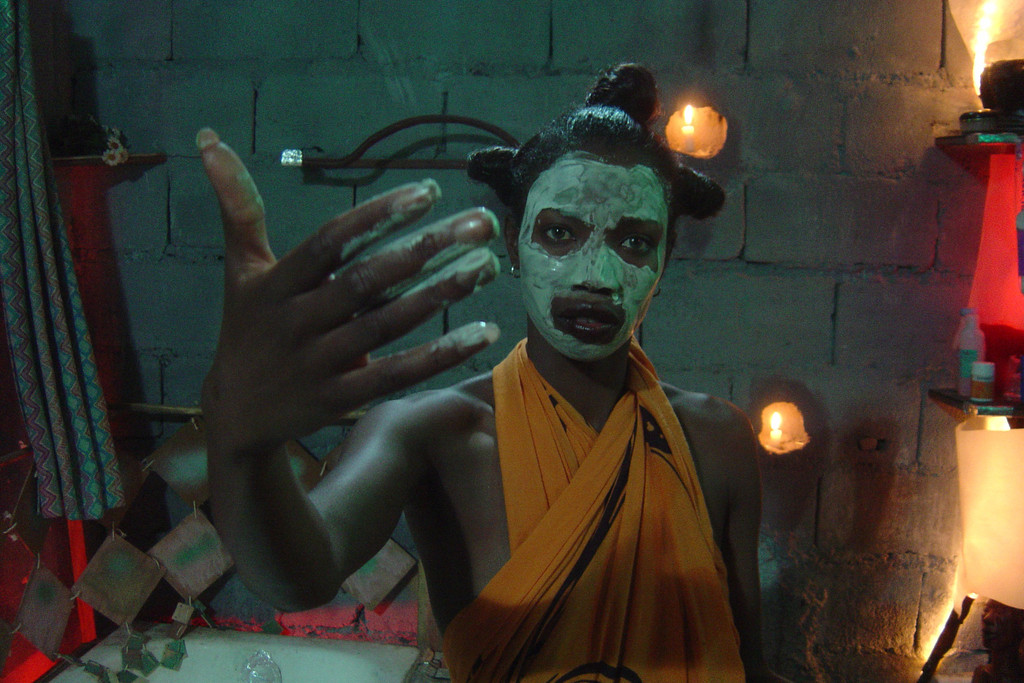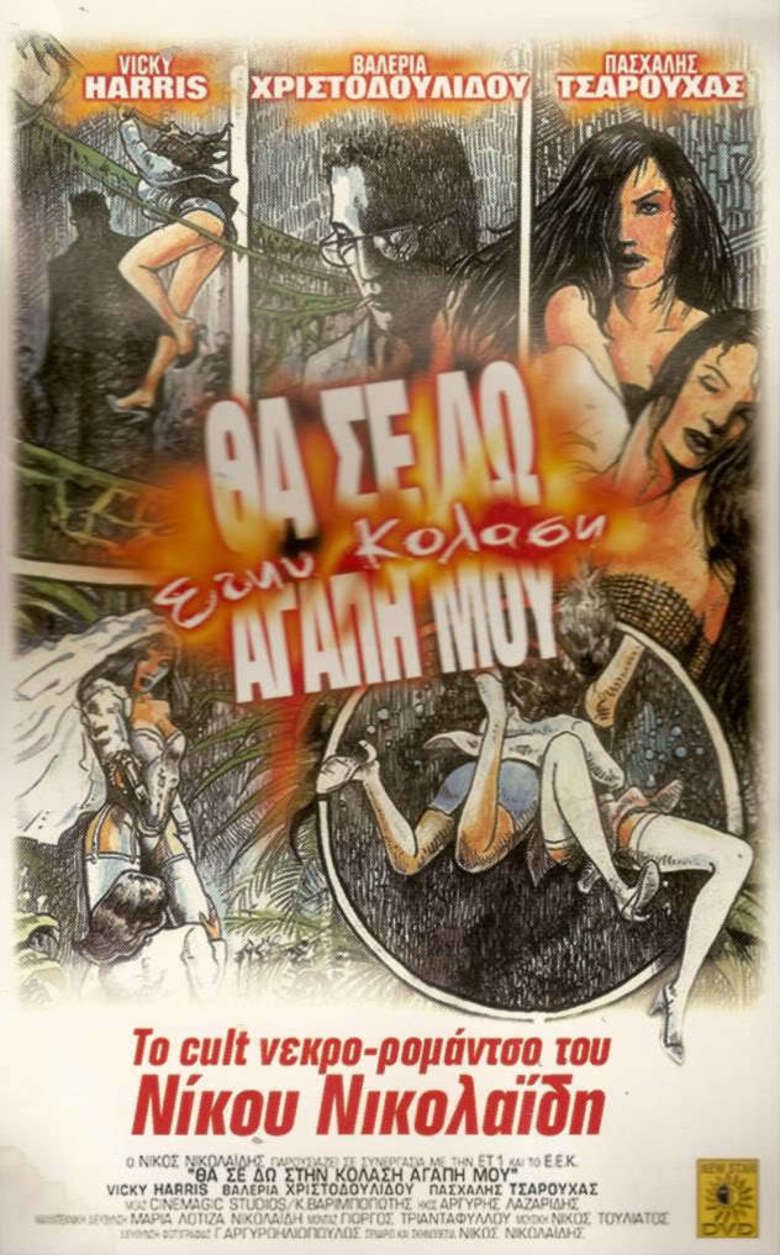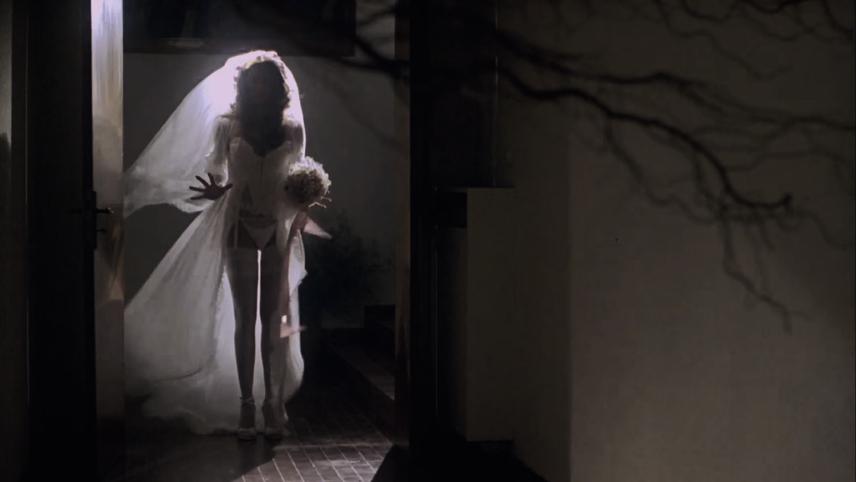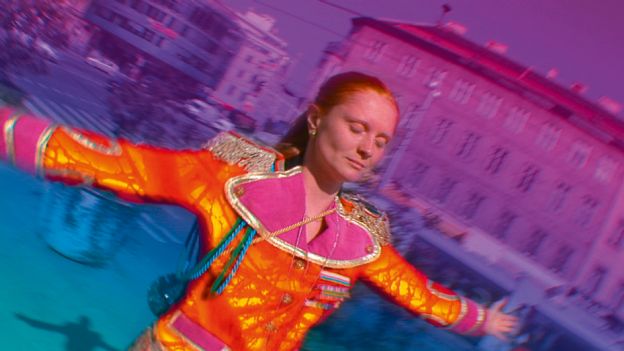| From http://superselected.com/wp-content/uploads/2014/08/Les_Saignantes.jpg |
Director: Jean-Pierre Bekolo
Screenplay: Jean-Pierre Bekolo
Cast: Majolie as Adèle Ado); Chouchou
(Dorylia Calmel); Emile Abossolo M'bo as Ministre d'Etat; Josephine Ndagnou as Natou; Essindi Mindja as Essomba;
Alain Dzukam Simo as Rokko Véronique Mendouga as Dr. Amanga
 Synopsis: In an unknown African state in 2025, a Bloodette named Majolie
(Adèle Ado) accidentally kills the Secretary
General of the Civil Cabinet, a very important man in the government, after sex.
Getting the assistance of another Bloodette and close friend Chouchou (Dorylia Calmel) to dispose the body,
they find themselves pulled into the local custom of funeral mornings for
important figures, which immediately causes problems with their attempts to
dispose the SGCC, particularly as a corrupt male political figure in the
government becomes aware of the pair and tries to sexually blackmail them in
exchange for money. The women however have one advantage on their side, the
ancient ritual of the Mevoungou, presided over by older sorceresses and their
own abilities.
Synopsis: In an unknown African state in 2025, a Bloodette named Majolie
(Adèle Ado) accidentally kills the Secretary
General of the Civil Cabinet, a very important man in the government, after sex.
Getting the assistance of another Bloodette and close friend Chouchou (Dorylia Calmel) to dispose the body,
they find themselves pulled into the local custom of funeral mornings for
important figures, which immediately causes problems with their attempts to
dispose the SGCC, particularly as a corrupt male political figure in the
government becomes aware of the pair and tries to sexually blackmail them in
exchange for money. The women however have one advantage on their side, the
ancient ritual of the Mevoungou, presided over by older sorceresses and their
own abilities.
The Bloodettes, even if it isn't perfect, presents an ambitious
idea of a Film Noir soaked political sci-fi film made in Cameroon. Shot on the
streets rather than attempting an elaborate fantasy world, the film's minimal
nature is for the better and for a sense of mood. Director Jean-Pierre Bekolo explicitly presents an African country of 2015, not
dissimilar to 2005 Cameroon or to most
places within the 2010s. Barring the voice automation to drive cars and little
details, post-colonial Africa is still stuck in a terrible scenario, corrupted
by politics and industry regardless of the era. Whilst old depictions of the
future, even the campiest, can be as rewarding Bekolo's intent for the film is greatly helped by shooting in real
locations. That amongst the murky back streets and industrial areas, it's an
environment which suits the sense that his lead heroines have to scrape to
survive.
Patriarchy is still a huge issue
within this world that is very bleak and inhospitable. The Bloodettes, Majolie
and Chouchou, have the advantage of an ancient magical rite. Yes, said rite to
a Western viewer can literally be described as a woman's own sex being magical.
This ritual, the Mevoungou, is however a real custom that was eroded away by
Western influences and the director discovered through anthropological
documentation of his own Beti heritage. One of the biggest problems so what may seem strange and trite for a
Western viewer is actually a very political and feminist subject being brought
to screen.
There is, without any of this context, a slight absurdity at first to the Bloodettes using their sexuality to force stun people a couple of times, through synchronous dancing and gyration. But that not only reveals a conscious bias and shame in a viewer (even myself honestly) when talking of sexuality, but knowing that it's based on a real culture of female empowerment, lost in the wave of Western influence and practices like female genital circumcision, forces one to step out of this childish viewpoint. To realise how sex magic (magick) alongside ancient traditions like Mevoungou come from the state of reassessing the human sexual body as a force of great power. Its more significant as this is an African custom, not a Western one, and alongside the huge stumbling blocks in Western culture itself with sexuality, there's also the huge issue of how the West ostracises "exotic" customs behind our history of material social progression by showing it as another even within that culture's own history, forgetting that we're viewing a lot of this never actually within these countries. In this film's case as well, this is a topic with racial and engendered politics which means not knowing the context of the Mevoungou, which I only learnt of through writing this, places a viewer in danger of entirely dismissing a film as merely a cultural oddity when it's a cultural film in its own country with a very loaded context.
Two very strong women are our
leads. Whilst they are likely in sex work, they are very strong figures looking
out for themselves. Barring one shower scene, very little in terms of
sexualisation of a male gaze is found, instead the sensuality of the
protagonists theirs and in their control, both of their own bodies in front of
others and the Mevoungou. Everything else is entirely about these figures
trying to overcome corrupt male figures. Sometimes with their whits about them,
like trying to convince a butcher that the SGCC's body is good beef, eventually trying to
acquire a body for the head when they find themselves in the midst of funeral
morning customs. Then however they have the Mevoungou. An essay Re-Imagining West African Women’s
Sexuality: Jean Pierre Bekolo’s Les Saignantes and the Mevoungou by Naminata Diabate describes that, yes,
the Mevoungou is literally a Beti custom surrounding the female clitoris. That
it has a profound magical importance which older and younger Beti women were
participants of and gave their power with a literal spiritual edge over men. In
this, even against the corrupt younger male politician with his own strategies,
our heroines have their ancestral ritual to assist them, alongside a council of
older women who can bend reality such as vanish in a blink of the eye.
 |
| From https://images-na.ssl-images-amazon.com/images/ M/MV5BM2NiNzI5YjEtZWU5OS00ODFkLTlmNzItMjA4 NzAwZGM3ZWMyXkEyXkFqcGdeQXVyNzczOTc5ODI@._V1_.jpg |
If the film has a problem is that it's trying to flesh itself out as a fully built work but with some obvious problems with its structure. What happens in the plot does feel anaemic by the end, an attempt to rip off a corrupt politician losing a great deal without knowing its context in terms of feminist/folk cultural politics. Neither does it help that this involved awkward under-cranked fight scenes which don't help any production. That the subplot where morning very influential people have replaced night's entertainments could've been established further more too, especially as disposing a body is a huge part of the plot originally. Where The Bloodettes stands proud and can overcome these issues is its attitude and style. How stylish its low budget and economic look is, especially as its entirely shot at night, an atmosphere both in the dark streets and the harshness of indoor lighting. Even the almost Godardian cutaways, to a bill board with different statements on them commenting how different genres are not possible - such as horror when death is a party - mean a lot more on this viewing as interesting self-reflections on the content within, the director clearly pastiching genres on purpose. And of course there's its empowerment of women, and especially black women from a non-English speaking country, with this film both in its use of a cultural ritual for women that could've been lost in history and how it generally depicts its leads as very resourceful figures helping to push over the stain on their country's soul. Something which we are in dire need of more in cinema and preferably in an unconventional work like The Bloodettes, not a sanitised and toothless creation to appeal to bland white English speaking middle class communities like some of the worst films for tokenism are made for.
Abstract Spectrum: Genre Hybrid/Psychotronic
Abstract Rating (High/Medium/Low/None): None
Personal Opinion:
A gem. Imperfect but shining with
originality. It's a film in dire need of rediscovery for this and as a capsule
of both an environment and a folklore that, alongside being more progressive
than some modern "progressive" ideals, is something that you wouldn't
know of unless you had films like this, the Mevoungou and its importance for
women of a specific African culture allowed to thrive onscreen and not seem
like a mere relic.
 |
| From https://images-na.ssl-images-amazon.com/images/M/MV5BZWI3ZGU5OTQtNzFjZC00NWU2LTgy MWEtOGE3ZGQ5OWU2MTVmXkEyXkFqcGdeQXVyNzczOTc5ODI@._V1_.jpg |








